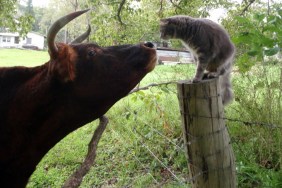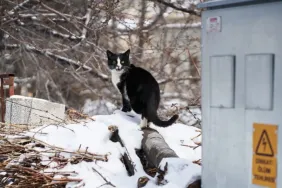The clinical evidence that H1N1 influenza virus infects both people and animals should make all pet owners take notice. Recently, I published Reemergence of H1N1 Influenza Virus in Wisconsin Cats Raises Important Public Health Concerns after human caretakers spread their illness to household feline friends.
Influenza viruses have proven capable of transmitting between organisms via direct contact with bodily secretions and even mutating by genetically combining with viruses otherwise known to infect different species (see Swine Flu Pandemic Over But H1N1 Hybrid Virus Emerges).
Until the unromantic Feb 14, 2011 announcement that H1N1 infected cats in Wisconsin, the last confirmed positive case of H1N1 in companion animals was in January, 2010. All reports of H1N1 infection in pets are thoroughly detailed on the American Veterinary Medical Association 2009 H1N1 Flu Virus Outbreak website.
With each passing month, more cases of H1N1 are materializing in multiple species. In 2011, we started with cats, moved onto ferrets, and now another cat tested positive for H1N1. Will dogs or other companion animals be the popular trend for spring? Dogs have been infected in the past, with confirmations occurring in New York (see First US canine 2009 H1N1 infection confirmed in New York) and in China (see H1N1 Swine flu infects dogs in China).
In early March, a Kentucky ferret shelter was struck by the virus, which led to the euthanasia of one ferret and positive confirmation from one of the remaining survivors. In this viral “hot zone”, all ferrets showed respiratory tract clinical signs, such as lethargy, cough, sneeze, nasal discharge, and altered breathing pattern). Fortunately, all ferrets survived, but for the one that was euthanized. A shelter worker suffering from mild, flu-like symptoms was reportedly the source of infection.
My home state of California had its first confirmed positive case of H1N1 in 2009, when Maddie the cat became sick and ultimately recovered (see Los Angeles Cat is California’s First Confirmed 2009 H1N1 Virus Infection in Domestic Feline).
Recently, a second case has been verified in California when a cat reportedly having a history of chronic respiratory tract disease tested positive for H1N1 and other viral (Feline Herpesvirus Type 1 and Calicivirus) and bacterial (Mycoplasma felis) agents. It is speculated that these other infectious organisms may have made the cat more susceptible to infection with H1N1. The cat’s owner reportedly was sick with the flu shortly before her pet’s symptoms appeared and diagnostic testing (Idexx Feline Upper Respiratory Disease Real PCR Panel) was performed.
This recent rash of illness makes me reinforce that humans, as caretakers of each other and animals, must be vigilant in maintaining good health habits and hygiene. Strive to promote a healthy immune system in both you and your pet through a nutritious diet, regular exercise, adequate hydration, sufficient rest, and stress reduction. Additionally, make sure to immediately address illness with a health professional and prevent spread of infectious organisms by avoiding close contact with other people and pets when you are sick.
Dr. Mahaney graduated from the University of Pennsylvania School of Veterinary Medicine and is also a Certified Veterinary Acupuncturist. He lives and practices in Los Angeles, California, and works closely with local rescue organizations. He also writes for Los Angeles Pet Care Examiner column.









